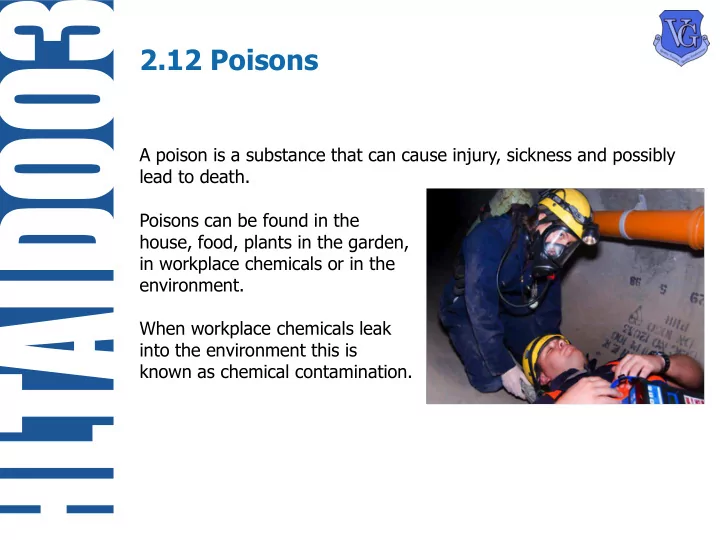

2.12 Poisons A poison is a substance that can cause injury, sickness and possibly lead to death. Poisons can be found in the house, food, plants in the garden, in workplace chemicals or in the environment. When workplace chemicals leak into the environment this is known as chemical contamination.
2.12 Poisons Poisons can enter the body by contact with the skin, ingested, injected or inhaled and they can be solid, liquid or gas (including fumes and vapours). Many poisons may only be harmful if exposed to larger quantities. As with any medical emergency it is important to try and identify the source of the poison and illness so that it may be treated appropriately.
2.12 Poisons Inhaled Poisons : Gases, including: carbon monoxide from an engine, carbon dioxide occurring naturally from decomposition, nitrous oxide used in medicine, chlorine used in pools and cleaning. Fumes from sources such as: glues, paints, petrol, drugs, including cocaine, as well as other odourless fumes.
2.12 Poisons Ingested Poisons : Medications. Contaminated foods including mushrooms and shellfish. Alcohol. Cleaning products. Pesticides. Plants.
2.12 Poisons Injected Poisons : Those obtained through the bite or sting of insects, spiders, snakes, marine animals. Those from drugs or medications injected through a needle/sharp object.
2.12 Poisons Absorbed Poisons enter the body through the skin, mucous membranes or other body surfaces, including: Plants. Chemicals. Fertilisers and pesticides.
2.12 Poisons Common signs and symptoms of poisoning: Chest and/or abdominal pain. Nausea. Vomiting. Diarrhoea. Difficulty breathing/irregular breathing. Seizures. Presence of drugs. Sweating. Altered conscious state. Burns around the lips and tongue.
2.12 Poisons General Treatment Principles If the person is conscious and the scene is safe immediately call the Poisons Information Centre on 13 11 26 . The operator will tell you what to do and whether an ambulance should be called. If the person is unconscious call 000 or 112.
2.12 Poisons General steps for dealing with a poisons situation are: If the Patient is Conscious: 1. Survey the scene. i. If necessary move the person from the scene using manual handling techniques. ii. If you think there are still gases/fumes in the air use extreme caution. Do not enter the scene if it will endanger your own life – call for emergency services. 2. Conduct a Primary Survey and follow DRS ABCD. 3. If the casualty is conscious conduct a secondary survey and gather extra information. 4. Collect any relevant items. 5. Call the Poisons Information Centre on 13 11 26 or the emergency number.
2.12 Poisons If the Patient is Unconscious: 1. Check their airways and DRS ABCD Basic Life Support process. 2. Call for an ambulance – Dial 000 or 112.
2.12 Poisons
2.12.1 Substance Misuse – Alcohol & Other Drugs Any drug can be misused when it is taken outside approved medical uses. With over-the-counter or other commonly used drugs, there are strict instructions on the package of the drug that specifies the daily dosage. Examples are aspirin, ibuprofen, paracetamol, acetaminophen (Tylenol) and products that contain codeine. With all prescription drugs there is a sticker label with the name of the patient, the daily amount to be taken and when to take the medication.
2.12.1 Substance Misuse – Alcohol & Other Drugs Substance misuse occurs when a person takes an overdose of a drug and it becomes toxic to the cells and organs in the body. There are accidental and intentional overdoses. As a result, a drug overdose can be life-threatening and require first aid management. Illicit drugs or street drugs are those obtained without a prescription and are illegal to possess.
2.12.1 Substance Misuse – Alcohol & Other Drugs Since drug users can inject drugs into their veins first aid management includes treating the patient for “needle stick injuries” as there may be multiple injection sites. Alcohol overdose can be harmful and in extreme cases cause death. Prescription drugs, over-the- counter remedies and illicit drugs can lower the person’s tolerance of alcohol when taken together.
2.12.1 Substance Misuse – Alcohol & Other Drugs Too much alcohol consumption can cause drunkenness, impair judgment and make the person more prone to accidents in the workplace when operating machinery or driving. Binge drinking can slow respiration and lead to unconsciousness. Too much alcohol can cause death.
2.12.1 Substance Misuse – Alcohol & Other Drugs Signs and symptoms of alcohol and other drug poisoning: Skin – pale, clammy, cold. Nausea/vomiting/abdominal pain. Collapse/loss of consciousness. Drowsiness, confusion, hallucinations. Seizures. Mood changes. Difficulty or altered breathing.
2.12.1 Substance Misuse – Alcohol & Other Drugs First aid is similar to treating casualties who have been affected by poisonous substances. First aid treatments can include: If the Patient is Conscious: 1. Survey the scene. 2. Carry out a primary survey. 3. Call the Poisons Information Centre/local emergency number and follow directions. 4. Conduct a secondary survey. 5. Help the patient into a comfortable position and calm and reassure them. 6. Help maintain normal body temperature. 7. If the person becomes violent or threatening you should remove yourself from the area. Tell ambulance personnel if you think the person has used a “designer drug” as this can require different treatment and can affect how they respond to the incident.
2.12.1 Substance Misuse – Alcohol & Other Drugs If the Patient is Drowsy or Unconscious: 1. Check the person’s airways and follow DRS ABCD Basic Life Support process. 2. Call for an ambulance – Dial 000 or 112.
End of Section Part 2B QUESTIONS? QUESTIONS?
Recommend
More recommend